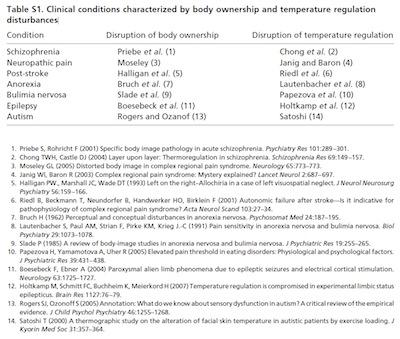In our paper in PNAS a couple of years ago, in which we showed that the RHI is associated with a drop in skin temperature of the ‘replaced’ hand, we proposed the idea that the result is relevant to a range of psychiatric and neurological disorders (check out the table we put in as supplementary info:
[table “” not found /]
- Priebe S, Rohricht F (2001) Specific body image pathology in acute schizophrenia. Psychiatry Res 101:289–301.
- Chong TWH, Castle DJ (2004) Layer upon layer: Thermoregulation in schizophrenia. Schizophrenia Res 69:149–157.
- Moseley GL (2005) Distorted body image in complex regional pain syndrome. Neurology 65:773–773.
- Janig Wl, Baron R (2003) Complex regional pain syndrome: Mystery explained? Lancet Neurol 2:687–697.
- Halligan PW., Marshall JC, Wade DT (1993) Left on the right–Allochiria in a case of left visuospatial neglect. J Neurol Neurosurg Psychiatry 56:159–166.
- Riedl B, Beckmann T, Neundorfer B, Handwerker HO, Birklein F (2001) Autonomic failure after stroke—Is it indicative for pathophysiology of complex regional pain syndrome? Acta Neurol Scand 103:27–34.
- Bruch H (1962) Perceptual and conceptual disturbances in anorexia nervosa. Psychosomat Med 24:187–195.
- Lautenbacher S, Paul AM, Strian F, Pirke KM, Krieg J.-C (1991) Pain sensitivity in anorexia nervosa and bulimia nervosa. Biol Psychiatry 29:1073–1078.
- Slade P (1985) A review of body-image studies in anorexia nervosa and bulimia nervosa. J Psychiatric Res 19:255–265.
- Papezova H, Yamamotova A, Uher R (2005) Elevated pain threshold in eating disorders: Physiological and psychological factors. J Psychiatric Res 39:431–438.
- Boesebeck F, Ebner A (2004) Paroxysmal alien limb phenomena due to epileptic seizures and electrical cortical stimulation. Neurology 63:1725–1727.
- HoltkampM, Schmitt FC, Buchheim K, MeierkordH(2007) Temperature regulation is compromised in experimental limbic status epilepticus. Brain Res 1127:76–79.
- Rogers SJ, Ozonoff S (2005) Annotation:Whatdoweknowabout sensory dysfunction in autism?Acritical review of the empirical evidence. J Child Psychol Psychiatry 46:1255–1268.
- Satoshi T (2000) A thermographic study on the alteration of facial skin temperature in autistic patients by exercise loading. J Kyorin Med Soc 31:357–364.
Well, now there is some evidence to support that idea. A group from Nashville Tennessee has put down their guitars and investigated the rubber hand illusion in people with schizophrenia. The used the usual method to induce the illusion – synchronous stroking of the real hand and the rubber imposter – the control condition was the usual control condition – asynchronous stroking of the real hand and the rubber imposter. They measured self-reported vividness of the illusion, proprioceptive drift (the perceived location of your own hand, estimated with your eyes closed) and change in skin temperature on both hands. They compared the schizophrenia group to a group of supposedly matched (although it is difficult to know how 21 controls can be matched to 24 patients – I suspect they mean 21 controls of similar age and gender distribution).
Here is what they found: (i) The usual – the illusion induces a drift and a drop in skin temperature on the real hand. Notably, these results were not as straightforward as one might predict – there was no proprioceptive drift for the controls and the drop in skin temperature was greater when the right hand was stimulated than when the left hand was stimulated. (ii) The effects were larger in patients than they were in controls. This supports previous findings using only self-report (iii) In the schizophrenic patients, the vividness of the illusion and change in skin temperature were related to measures of delusions.
One unexpected finding of their study was that of an out of body experience induced by the experimental protocol. They describe it at length and it is really quite intriguing – a good read. Rather than describe it again here, suffice to say that the illusion seemed to crack this individual’s entire sense of body ownership, not just that related to his arm. The experimental results and case study underpin the conclusion that schizophrenia is associated with a weaker and more flexible sense of body ownership.
The authors speculate on neural mechanisms and they focus on the usual suspect – the temperoparietal junction and the infraparietal lobe. These are the most frequent brain areas implicated in frank body disownership caused by damage – somatoparaphenia – and right temperoparietal seizure is associated with out of body experiences. They also raise the possibility of NMDA glutamate dysfunction in the mechanisms. That NMDA antagonists can mimic some of the symptoms of schizophrenia and are consistent with the development of schizophrenia seems consistent. The vividness of the rubber hand illusion is augmented in schizophrenic participants if they take ketamine, which is an NMDA antagonist. Finally, ketamine is the surest way to induce an out of body illusion experimentally.
So, the paper itself is well worth a read – it is a fascinating story and some of the data are sufficiently different to published findings (including our own) to induce some speculation from the authors. Check it out here – it is freely available for download.
About Lorimer Moseley
 Lorimer is NHMRC Senior Research Fellow with twenty years clinical experience working with people in pain. After spending some time as a Nuffield Medical Research Fellow at Oxford University he returned to Australia in 2009 to take up an NHMRC Senior Research Fellowship at Neuroscience Research Australia (NeuRA). In 2011, he was appointed Professor of Clinical Neurosciences & the Inaugural Chair in Physiotherapy at the University of South Australia, Adelaide. He runs the Body in Mind research groups. He is the only Clinical Scientist to have knocked over a water tank tower in Outback Australia.
Lorimer is NHMRC Senior Research Fellow with twenty years clinical experience working with people in pain. After spending some time as a Nuffield Medical Research Fellow at Oxford University he returned to Australia in 2009 to take up an NHMRC Senior Research Fellowship at Neuroscience Research Australia (NeuRA). In 2011, he was appointed Professor of Clinical Neurosciences & the Inaugural Chair in Physiotherapy at the University of South Australia, Adelaide. He runs the Body in Mind research groups. He is the only Clinical Scientist to have knocked over a water tank tower in Outback Australia.
Link to Lorimer’s published research here. Downloadable PDFs here.
References
Moseley GL, Olthof N, Venema A, Don S, Wijers M, Gallace A, & Spence C (2008). Psychologically induced cooling of a specific body part caused by the illusory ownership of an artificial counterpart. PNAS, 105 (35), 13169-73 PMID: 18725630
Peled A, Ritsner M, Hirschmann S, Geva AB, & Modai I (2000). Touch feel illusion in schizophrenic patients. Biological psychiatry, 48 (11), 1105-8 PMID: 11094144
Thakkar KN, Nichols HS, McIntosh LG, Park S, 2011 Disturbances in Body Ownership in Schizophrenia: Evidence from the Rubber Hand Illusion and Case Study of a Spontaneous Out-of-Body Experience. PLoS ONE 6(10): e27089. doi:10.1371/journal.pone.0027089
Morgan HL, Turner DC, Corlett PR, Absalom AR, Adapa R, Arana FS, Pigott J, Gardner J, Everitt J, Haggard P, & Fletcher PC (2011). Exploring the impact of ketamine on the experience of illusory body ownership. Biological psychiatry, 69 (1), 35-41 PMID: 20947068
Wilkins LK, Girard TA, & Cheyne JA (2011). Ketamine as a primary predictor of out-of-body experiences associated with multiple substance use. Consciousness and cognition, 20 (3), 943-50 PMID: 21324714



